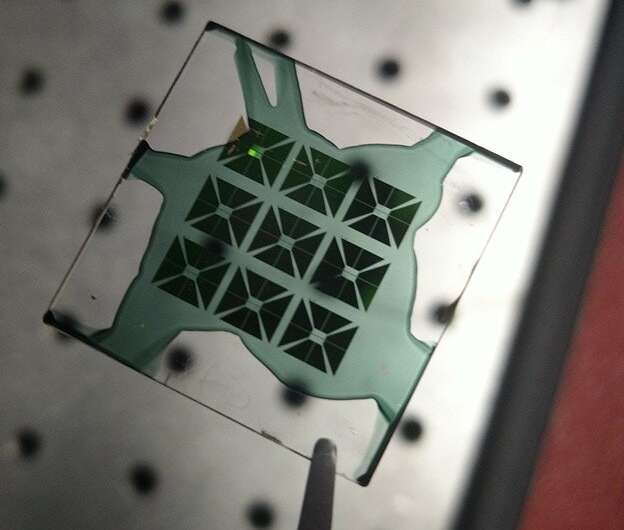Bridging optics and electronics: New spatial light modulator marries optical and electronic realms

Spatial light modulators are common optical components found in everything from home theater projectors to cutting-edge laser imaging and optical computing. These components can control various aspects of a light, such as intensity or and phase , pixel by pixel. Most spatial light modulators today rely on mechanical moving parts to achieve this control but that approach results in bulky and slow optical devices.
Now, researchers at the Harvard John A. Paulson School of Engineering and Applied Sciences, in collaboration with a team from Washington University, have developed a simple spatial light modulator made from gold electrodes covered by a thin film of electro-optical material that changes its optical properties in response to electric signals.
This is a first step towards more compact, high-speed and precise spatial light modulators that could one day be used in everything from imaging to virtual reality, quantum communications and sensing.
The research is published in Nature Communications.
"This simple spatial light modulator is a bridge between the realms of optics and electronics," said Cristina Benea-Chelmus, a postdoctoral fellow at SEAS and first author of the paper.
"When you interface optics with electronics, you can use the entire backbone of electronics that has been developed to open up new functionalities in optics."
The researchers used electro-optic materials designed by chemists Delwin L. Elder and Larry R. Dalton at the University of Washington. When an electric signal is applied to this material, the refractive index of the material changes. By dividing the material into pixels, the researchers could control the intensity of light in each pixel separately with interlocking electrodes.
With only a small amount of power, the device can dramatically change the intensity of light at each pixel and can efficiently modulate light across the visible spectrum.
The researchers used the new spatial light modulators for image projection and remote sensing by single-pixel imaging.
"We consider our work to mark the beginning of an up-and-coming field of hybrid organic-nanostructured electro-optics with broad applications in imaging, remote control, environmental monitoring, adaptive optics and laser ranging," said Federico Capasso, Robert L. Wallace Professor of Applied Physics and Vinton Hayes Senior Research Fellow in Electrical Engineering, senior author of the paper.
More information: Ileana-Cristina Benea-Chelmus et al, Electro-optic spatial light modulator from an engineered organic layer, Nature Communications (2021). DOI: 10.1038/s41467-021-26035-y




















